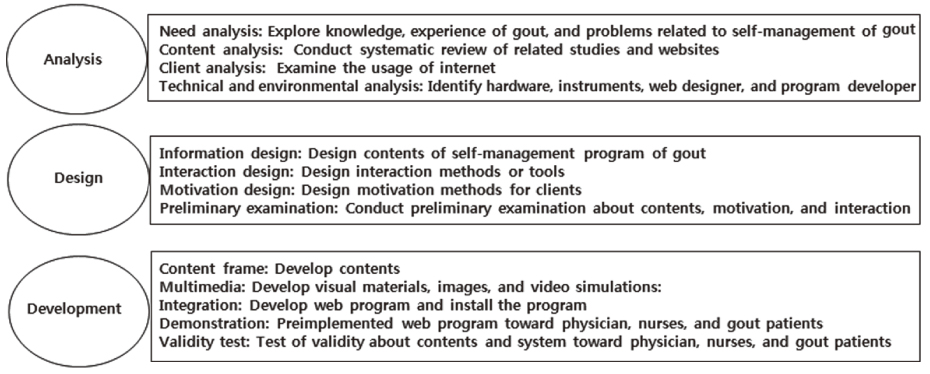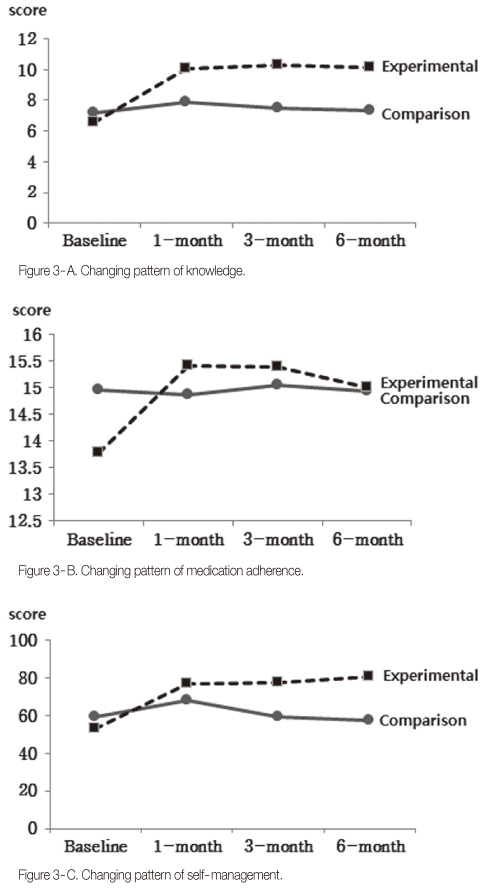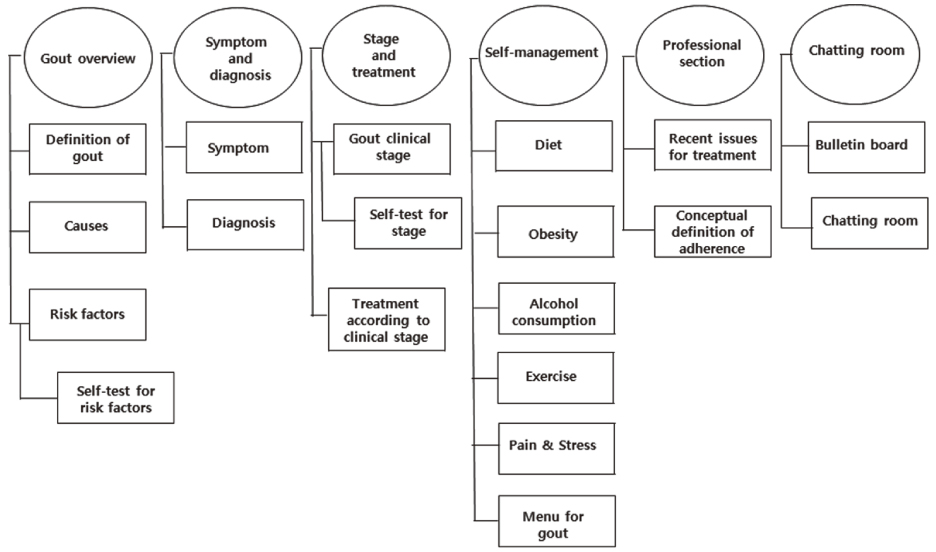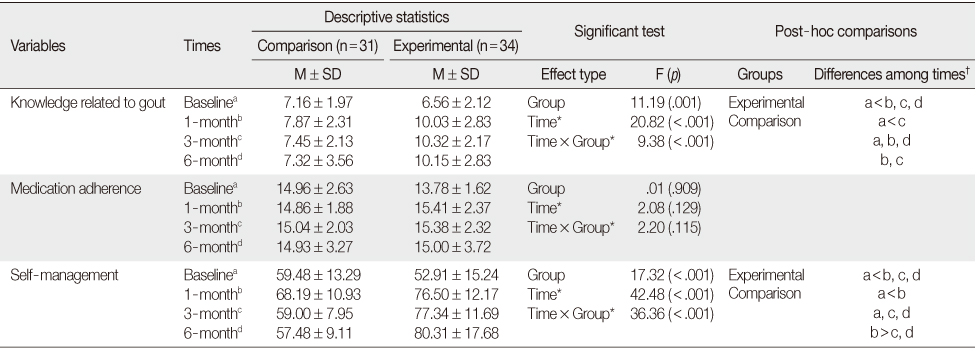Articles
- Page Path
- HOME > J Korean Acad Nurs > Volume 43(4); 2013 > Article
-
Original Article
- Effects of Gout Web based Self-management Program on Knowledge Related to Disease, Medication Adherence, and Self-management
- Hyun Soo Oh, Won Park, Seong Ryul Kwon, Mie Jin Lim, Yeon Ok Suh, Wha Sook Seo, Jong Suk Park
-
Journal of Korean Academy of Nursing 2013;43(4):547-556.
DOI: https://doi.org/10.4040/jkan.2013.43.4.547
Published online: August 30, 2013
1Department of Nursing, Inha University, Incheon, Korea.
2School of Medicine, Inha University, Incheon, Korea.
3Department of Nursing, Soonchunhyang University, Asan, Korea.
4Department of Nursing, Inha University, Inha University Hospital, Incheon, Korea.
- Address reprint requests to: Oh, Hyun Soo. Department of Nursing, Inha University, 100 Inharo, Nam-gu, Incheon 402-751, Korea. Tel: +82-32-860-8206, Fax: +82-32-874-5880, hsoh@inha.ac.kr
© 2013 Korean Society of Nursing Science
Abstract
-
Purpose
- This study was conducted to examine the changing patterns of knowledge related to disease, medication adherence, and self-management and to determine if outcomes were more favorable in the experimental group than in the comparison group through 6 months after providing a web-based self-management intervention.
-
Methods
- A non-equivalent control group quasi-experimental design was used and 65 patients with gout, 34 in experimental group and 31 in comparison group, were selected from the rheumatic clinics of two university hospitals. Data were collected four times, at baseline, at 1 month, 3 months, and 6 months after the intervention.
-
Results
- According to the study results, the changing patterns of knowledge and self-management were more positive in the experimental group than in the control group, whereas difference in the changing pattern of medication adherence between two groups was not significant.
-
Conclusion
- The results indicate that the web-based self-management program has significant effect on improving knowledge and self-management for middle aged male patients with gout. However, in order to enhance medication adherence, the web-based intervention might not be sufficient and other strategies need to be added.
This study was supported by funds from the National Research Foundation of Korea in 2010 (No. 41322) and Inha University Research Fund in 2013.
- 1. Arem H, Irwin M. A review of web-based weight loss interventions in adults. Obes Rev. 2011;12(5):e236–e243. http://dx.doi.org/10.1111/j.1467-789X.2010.00787.xArticlePubMed
- 2. Arvidsson S, Bergman S, Arvidsson B, Fridlund B, Tingström P. Effects of a self-care promoting problem-based learning programme in people with rheumatic diseases: A randomized controlled study. J Adv Nurs. 2013;69(7):1500–1514. http://dx.doi.org/10.1111/jan.12008ArticlePubMedPDF
- 3. Battersby MW, Ask A, Reece MM, Markwick MJ, Collins JP. The partners in health scale: The development and psychometric properties of a generic assessment scale for chronic condition self-management. Aust J Prim Health. 2003;9(3):41–52.Article
- 4. Choi HK, Curhan G. Coffee, tea, and caffeine consumption and serum uric acid level: The Third National Health and Nutrition Examination Survey. Arthritis Rheum. 2007;57(5):816–821. http://dx.doi.org/10.1002/art.22762ArticlePubMed
- 5. Conn DL, Pan Y, Easley KA, Comeau DL, Carlone JP, Culler SD, et al. The effect of the arthritis self-management program on outcome in African Americans with rheumatoid arthritis served by a public hospital. Clin Rheumatol. 2013;32(1):49–59. http://dx.doi.org/10.1007/s10067-012-2090-5ArticlePubMedPDF
- 6. El Miedany Y, El Gaafary M, El Arousy N, Ahmed I, Youssef S, Palmer D. Arthritis education: The integration of patient-reported outcome measures and patient self-management. Clin Exp Rheumatol. 2012;30(6):899–904.PubMed
- 7. Harrold LR, Mazor KM, Peterson D, Naz N, Firneno C, Yood RA. Patients' knowledge and beliefs concerning gout and its treatment: A population based study. BMC Musculoskelet Disord. 2012;13:180. http://dx.doi.org/10.1186/1471-2474-13-180ArticlePubMedPMCPDF
- 8. Helft PR, Eckles RE, Johnson-Calley CS, Daugherty CK. Use of the internet to obtain cancer information among cancer patients at an urban county hospital. J Clin Oncol. 2005;23(22):4954–4962. http://dx.doi.org/10.1200/jco.2005.09.621ArticlePubMed
- 9. Holman H, Lorig K. Patients as partners in managing chronic disease. Partnership is a prerequisite for effective and efficient health care. BMJ. 2000;320(7234):526–527.PubMedPMC
- 10. Insel KC, Einstein GO, Morrow DG, Hepworth JT. A multifaceted prospective memory intervention to improve medication adherence: Design of a randomized control trial. Contemp Clin Trials. 2013;34(1):45–52. http://dx.doi.org/10.1016/j.cct.2012.09.005ArticlePubMed
- 11. Kim DY, Lee HR, Nam EM. Assessing cancer treatment related information online: Unintended retrieval of complementary and alternative medicine web sites. Eur J Cancer Care (Engl). 2009;18(1):64–68. http://dx.doi.org/10.1111/j.1365-2354.2008.00944.xArticlePubMed
- 12. Kim KY, Schumacher HR, Hunsche E, Wertheimer AI, Kong SX. A literature review of the epidemiology and treatment of acute gout. Clin Ther. 2003;25(6):1593–1617.ArticlePubMed
- 13. Lee CH, Sung NY. The prevalence and features of Korean gout patients using the National Health Insurance Corporation database. J Rheum Dis. 2011;18(2):94–100. http://dx.doi.org/10.4078/jrd.2011.18.2.94Article
- 14. Meiner SE. Gouty arthritis: Not just a big toe problem. Geriatr Nurs. 2001;22(3):132–134. http://dx.doi.org/10.1067/mgn.2001.116378ArticlePubMed
- 15. Morisky DE, Ang A, Krousel-Wood M, Ward HJ. Predictive validity of a medication adherence measure in an outpatient setting. J Clin Hypertens (Greenwich). 2008;10(5):348–354.PubMedPMC
- 16. Neogi T, Hunter DJ, Chaisson CE, Allensworth-Davies D, Zhang Y. Frequency and predictors of inappropriate management of recurrent gout attacks in a longitudinal study. J Rheumatol. 2006;33(1):104–109.PubMed
- 17. Nolte S, Osborne RH. A systematic review of outcomes of chronic disease self-management interventions. Qual Life Res. 2012;http://dx.doi.org/10.1007/s11136-012-0302-8ArticlePDF
- 18. Oh HS, Park JS, Seo WS. Development of a web-based gout self-management program. Orthop Nurs. 2011;30(5):333–341. http://dx.doi.org/10.1097/NOR.0b013e31822c5c3fArticlePubMed
- 19. Patrick K, Calfas KJ, Norman GJ, Rosenberg D, Zabinski MF, Sallis JF, et al. Outcomes of a 12-month web-based intervention for overweight and obese men. Ann Behav Med. 2011;42(3):391–401. http://dx.doi.org/10.1007/s12160-011-9296-7ArticlePubMed
- 20. Prochaska JO, DiClemente CC, Norcross JC. In search of how people change. Applications to addictive behaviors. Am Psychol. 1992;47(9):1102–1114.ArticlePubMed
- 21. Reach G. Treatment adherence in patients with gout. Joint Bone Spine. 2011;78(5):456–459. http://dx.doi.org/10.1016/j.jbspin.2011.05.010ArticlePubMed
- 22. In: Rha IJ. editor. Web-based education. Paju: Kyoyookbook; 1999.
- 23. Roddy E, Mallen CD, Hider SL, Jordan KP. Prescription and comorbidity screening following consultation for acute gout in primary care. Rheumatology (Oxford). 2010;49(1):105–111. http://dx.doi.org/10.1093/rheumatology/kep332ArticlePubMed
- 24. Schumacher HR Jr, Chen LX. The practical management of gout. Cleve Clin J Med. 2008;75:Suppl 5. S22–S25.Article
- 25. Song TM, Park EJ, Lim EJ. The survey of the demand for health information on the internet. J Korean Soc Med Inform. 2002;8(2):17–24.ArticlePDF
- 26. Spencer K, Carr A, Doherty M. Patient and provider barriers to effective management of gout in general practice: A qualitative study. Ann Rheum Dis. 2012;71(9):1490–1495. http://dx.doi.org/10.1136/annrheumdis-2011-200801ArticlePubMed
- 27. Wantland DJ, Portillo CJ, Holzemer WL, Slaughter R, McGhee EM. The effectiveness of web-based vs. non-web-based interventions: A meta-analysis of behavioral change outcomes. J Med Internet Res. 2004;6(4):e40. http://dx.doi.org/10.2196/jmir.6.4.e40ArticlePubMedPMC
REFERENCES
Figure & Data
REFERENCES
Citations

- MoCA Domain-Specific Pattern of Cognitive Impairment in Stroke Patients Attending Intensive Inpatient Rehabilitation: A Prospective Study
Benedetta Basagni, Serena Malloggi, Cristina Polito, Leonardo Pellicciari, Silvia Campagnini, Silvia Pancani, Andrea Mannini, Paola Gemignani, Emilia Salvadori, Sara Marignani, Fabio Giovannelli, Maria Pia Viggiano, Bahia Hakiki, Antonello Grippo, Claudio
Behavioral Sciences.2024; 14(1): 42. CrossRef - The Impact of mHealth-Based Continuous Care on Disease Knowledge, Treatment Compliance, and Serum Uric Acid Levels in Chinese Patients With Gout: Randomized Controlled Trial
Ying Wang, Yanling Chen, Yuqing Song, Hong Chen, Xin Guo, Ling Ma, Huan Liu
JMIR mHealth and uHealth.2024; 12: e47012. CrossRef - Development and evaluation of a self‐management application for patients with gout
Seung Gum Kang, Eun Nam Lee
Japan Journal of Nursing Science.2020;[Epub] CrossRef - A 2‐year prospective follow‐up study of temporal changes associated with post‐stroke cognitive impairment
HyunSoo Oh, JongSuk Park, WhaSook Seo
International Journal of Nursing Practice.2018;[Epub] CrossRef



Figure 1
Figure 2
Figure 3
Effects of Web-based Intervention Program on Knowledge, Medication Adherence, and Self-management for Patients with Gout (N=65)
*Repeated Measure ANOVA was performed. As Mauchly's test of Sphericity was rejected, results of Greenhouse-Geisser correction were selected and interpreted; †For post-hoc comparisons, series of paired t-test were performed and in order to reduced type I error, significant level was set as p ≤.010.
*Repeated Measure ANOVA was performed. As Mauchly's test of Sphericity was rejected, results of Greenhouse-Geisser correction were selected and interpreted; †For post-hoc comparisons, series of paired t-test were performed and in order to reduced type I error, significant level was set as
 KSNS
KSNS
 E-SUBMISSION
E-SUBMISSION




 Cite
Cite

